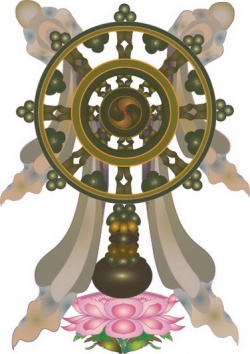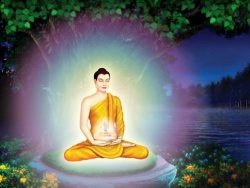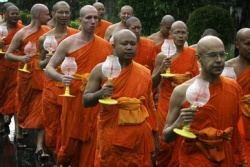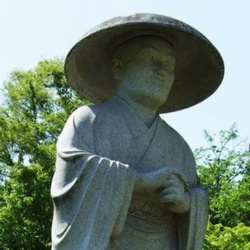Lifestyle-Monastic
Undertaking training in any field requires commitment.
Without it the best of intentions can founder. Without any form of supporting 'container' our finest resolutions can leak away.
The monastic form creates very clear boundaries, particularly around behaviour as moral and social codes [see: VINAYA).
Monasticism and training are ideally synonymous.
The idea of developing a standard of proficiency through practice and instruction requires effort and a monastery tries to provide the role model - seen in the life of senior monastics - and the teachings with clear guidelines for practice.
The monastery creates the opportunity - the effort can only be made by each individual.
Getting in:
It usually all begins with the first Noble Truth.
Some dissatisfaction comes into life and alternatives are sought. There are many opportunities in a Buddhist monastery for lay people and so they come - perhaps for a meditation workshop or a retreat or to visit the library or to just wander about the grounds.
For many, there is something that registers as 'interesting' - or even inspiring - and they come back.
Most monasteries have some guest accommodation for lay people and this is often the next step - a stay of some days or weeks. Each monastery will have different limitations on the length of a visit but the question will eventually arise: 'what are your long term plans?'
There are two things to consider here:
• monasteries are primarily for monks and nuns (the sangha) to live in and:
• to be able to sustain the level of training - which reflects the 'quality' of a monastery - the ratio of lay people to monastics needs to be kept balanced. This is also true of the ratio of junior to senior monastics.
The process of training a monk or nun is one that involves time and is not just about 'learning the rules.'
There is much that can only be learnt by patient observation.
Even patience itself is something that often needs to be cultivated and junior people tend not always to have this quality - so, if there are too many of them, their views and opinions can disproportionately dominate - to the overall detriment of the community.
After several weeks or a few months, if there is a wish to continue living in the monastery, then the next step is ordination as a novice.
The monk or nun overseeing guests will make this wish known to the sangha who will consider that person's suitability.
There is no test or exam and the decision is quite organic with factors such as willingness, honesty, being open to criticism, the ability to get along with others and give up to the group dynamic and so forth having more importance than worldly skills, like being able to cook or build.
The time from requesting ordination to a decision being made can vary a lot and until the sangha feels comfortable about accepting a candidate they often just wait.
This can be a bit frustrating, even unsettling, for candidates as many people are used to the 'in or out' job interview approach.
There is no hurry.
Where is there to go? It is usually not a very protracted process for novice ordination and the majority who wish to receive this ordination.
• The new novice is expected to commit to a stay of one years training under the general guidance of the sangha.
The ordination ceremony itself is quite simple.
It would usually be in the evening on a full moon day, as part of the communities usual observance, and the candidate would have had help learning the necessary chanting and the 'choreography' of the ritual.
Initially novices wear all white - this is a practice in itself - and they would be helped to procure (or sew) two or three sets of such clothing.
They wear a 'wrap' on formal occasions - the beginnings of learning to wear a robe. Someone would help them shave their head - another practice in mindfulness.
It is done with an open edged razor and heedlessness is directly visible as blood.
The ceremony involves formally requesting a period of training from the senior monk and the taking of the Three Refuges and Eight Precepts.
They are now called anagarika.
Much of the anagarika's life is around offering service and generally being willing to help with whatever needs doing.
It is appreciated that there is much that is new for the anagarika so there is a lot of tolerance around what is expected and time is allowed to adjust to the new life. There is no stigma if they choose to leave at any time.



